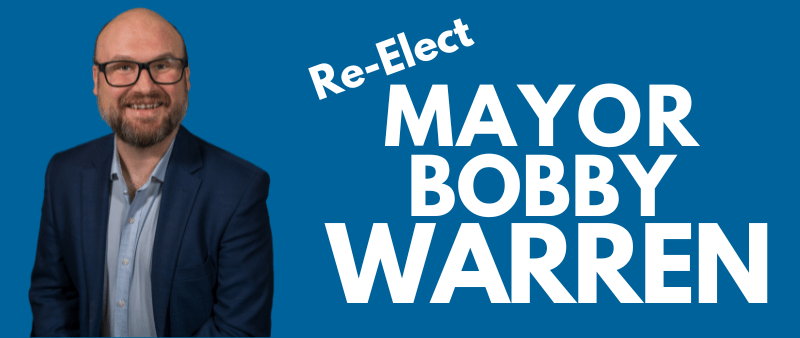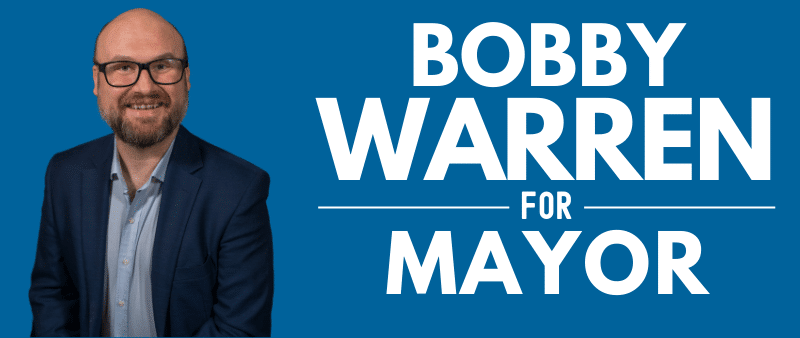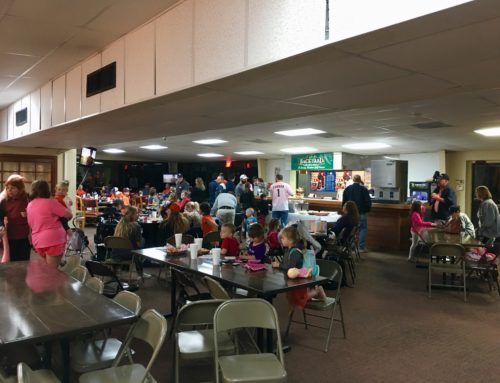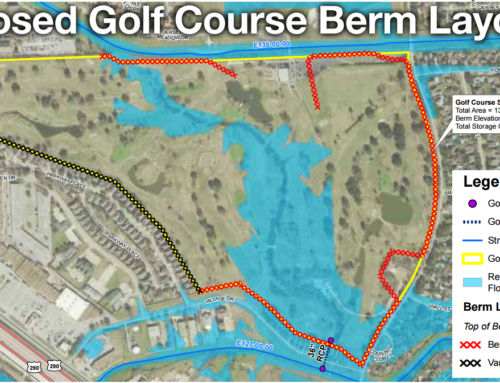Next to the issue of flooding, the subject of the Jersey Meadow golf course is highly likely to strike up a very polarizing discussion among residents in Jersey Village. Each of us have likely heard from at least one person on each side of the argument. Those in favor of keeping the golf course point to the prestige it provides and the benefit of the ample green space. People who favor getting rid of the golf course cite the fact that the golf course doesn’t support itself and that golf is a “dying” sport. But is it as simple as that?
In this article, I want to give you some insight into how I, as a member of the Jersey Village City Council, approach the issue of the golf course. As you’ll learn, it’s not as simple as saying, “Taxpayers subsidize it, so let’s get rid of it.” After all, by that criteria, very few functions of government would ever survive.
Why did Jersey Village buy the Jersey Meadow Golf Course?
Before we look into why the golf course has been kept by the city to date, it might help to look a bit more closely at why the golf course was ever purchased at all. To review the full timeline based on the minutes of the city council and the golf course committee, click here. In July 1998, the Jersey Village City Council appointed a number of citizens to a Golf Course Committee to advise on whether to purchase the Jersey Meadow Golf Course, which at that time was owned and operated privately.
The Committee believed that it was in the best interest of the city to purchase the course for a number or reasons, but some of these reasons seem to stand out most:
- There was concern that the golf course would be sold to developers, which could contribute to what were already significant flooding problems at the time.
- Based on the consultant’s report, the golf course could break even and possibly even generate positive revenue, provided some upgrades were made to the facilities, including to the clubhouse.
After reviewing all aspects of the course, and hiring consultants and appraisers to evaluate the value of the course, it was determined that it would be in the best interest of the city to buy the golf course. The city council voted unanimously to authorize the city manager to purchase the golf course on June 12, 2000. The course was purchased for $6,991,000. When inflation is accounted for, this is equivalent to $9,996,806 today.
How much is the golf course worth today?
Let’s set aside the question of the golf course’s value as a golf course. That’s a much more complex question that I’m in no position to answer. Instead, it’s worth pointing out that the value of land around 290 and Jones Rd. is much higher than it was in 2000 when the golf course was purchased.
Based on my research of large undeveloped land in the area, prices of $4-7 per square foot are fairly common. With 122 acres of contiguous land this close to 290, which is difficult to come by this close to Houston today, an estimate of $30-$40 Million for the land alone would be extremely conservative. If anyone was interested in continuing to operate it as a golf course, the value could be quite a bit higher.
Therefore, when you hear someone talk about how much was paid for the golf course, or the financing involved, it’s important to also keep in mind that there’s an extremely valuable asset attached to those payments. Therefore, for the purpose of discussing the finances of the golf course, I’m going to focus on the operations, not the financing for the purchase. While one may try to argue that the city “overpaid” for the golf course, it would be difficult to say that the decision wasn’t profitable.
What is the current financial condition of the golf course?
This is one area where a significant amount of misinformation is spread. My hope is that the information below will help you to reach your own conclusions about the financial history of the golf course, which helps to inform the viability of the golf course going forward.
Some have asked about the precise data for the golf course, with revenues and expenses summarized in an easy to read format. Admittedly, the city’s finances can be hard to understand at times, but our city staff is working on improving that as part of attempt to increase transparency. In the meantime, click here to download a summary of the golf course finances since its purchase by the city during the 1999-2000 fiscal year.
It may help to cover some fundamentals about municipal finance as we cover the various aspects of the golf course finances.
Cities in Texas maintain one or more funds through which revenues are collected and expenses are paid. The primary fund cities use for this purpose is called a General Fund. In the City of Jersey Village, the General Fund contains revenues collected from property tax, most of the local portion of sales tax (1/2 cent goes to a fund for crime prevention), and revenues from fines, warrants, permits, licenses and fees. The expenses paid out of the General Fund are the kind that we typically think about when we think of local government: police, fire, parks, general infrastructure maintenance, etc. These revenues and expenses generally constitute “governmental activities”.
On the other hand, the city also maintains funds that are considered “enterprise funds”. When a local government engages in business-like activities, they typically track the revenues and expenses in a dedicated enterprise fund. Jersey Village maintains two enterprise funds: the Utility Fund, which handles revenues and expenses related to operating our water and wastewater utility services, and the Golf Course Fund, which handles revenues and expenses of operating the golf course.
Having a separate fund for business-like activities makes it easier to understand whether that particular activity is self-sufficient or if it is being subsidized by the city through other means.
Transfers from General Fund to Golf Course Fund
In this case, no one disputes that the golf course is currently not self-sufficient. But in order to understand the degree to which the golf course isn’t self-sufficient, we have to look to transfers into the Golf Course fund. Let’s start by looking at last year’s budget at year end.
This represents the total cash flow from the general fund to the golf fund for the 2016-2017 fiscal year (the city’s fiscal year begins on October 1st of each year).
This number has varied from year to year. Here are the transfers for the past several years and are reflected in the Excel spreadsheet to which I have linked above (as taken from the audited Comprehensive Annual Financial Report for each fiscal year, unless otherwise noted):
- 2017-2018: $353,071 (budgeted)
- 2016-2017: $346,171 (from final budget report, as illustrated above)
- 2015-2016: $454,905
- 2014-2015: $428,202
- 2013-2014: $66,818
- 2012-2013: $0
- 2011-2012: $0
- 2010-2011: $0
Are you noticing a trend as well? It wasn’t that long ago that the daily operation of the golf course was self-sufficient without the need for general revenues to supplement it. While it could be a coincidence that the need to supplement the golf course fund began around the same time US Highway 290 construction began to really interfere with traffic in and out of Jersey Village, that seems to be a pretty strong correlation.
What is your family’s share of this subsidy?
Let’s assume for the moment, for the purpose of argument, that the deficit doesn’t go away once US Highway 290 construction is complete and revenues remains approximately at the current level. How much does the average family pay toward this subsidy? Let’s use the example of a family living in a home valued at $300,000 with a residential homestead exemption applied to it. This family currently pays $2,049.30 in property taxes to the City of Jersey Village each year. If we use the 2017-2018 fiscal year budget and the projected transfer from the General Fund to the Golf Course fund for 2017-2018, we find that the transfer constitutes 2.11% of the expenditures budgeted from the general fund.
Therefore, our hypothetical family’s share of that subsidy is $43.24 for this fiscal year.
If your home has a tax assessment value below $300,000 or if you have exemptions other than the standard homestead exemption (such as the over-65 exemption), your family’s share of this cost is even less.
Sales tax revenue generated from golf course activities
Also, keep in mind that the golf course contributes to general revenues and crime prevention as well. Most of the activities that generate revenues at the golf course are subject to sales tax. Of the 8.25% sales tax that is collected in Jersey Village, 1.5% goes into the General Fund, and 0.5% goes to the Crime Prevention Fund which helps pay for additional police officers and equipment. Based on the last five fiscal years, the golf course has generated anywhere from $22,000 to $26,000 in sales tax revenue for the city and the crime control district.
Depreciation
You might notice that depreciation is kept as a figure separate from the rest of the expenses. The reason this is done is because depreciation is required to be calculated due to the golf course fund being maintained as an enterprise fund (see the discussion above regarding municipal finance and use of funds). Ordinarily, depreciation is used to deduct the cost of an asset over a number of years on income tax returns. As a government entity, obviously the city doesn’t pay income taxes. Therefore, depreciation serves no role. Instead, assets are aged out and replaced through the use of payments to the capital improvement fund from the golf course fund, as described below.
We own a golf course – now what?
Now that we understand why the golf course was purchased and how much a typical homeowner pays in property taxes towards subsidizing the golf course, let’s look at what we can do about it.
We can’t go back in time and “undo” the purchase. So let’s look at some of the proposals that have been bandied about and examine the pros and cons of each.
Why don’t we turn the golf course into a detention pond?
Turning the golf course into a large detention pond connected to the bayou is the option that is frequently advocated by some of the more vocal opponents of the golf course. The problem here is that Jersey Village doesn’t have the jurisdiction to do this on its own. The Harris County Flood Control District would need to evaluate the feasibility of adding additional detention capacity so close to an existing detention pond just north of the golf course. In fact, that detention pond was part of the golf course at the time that the City of Jersey Village purchased it from private ownership.
Moreover, there exists the question of where our flooding is currently coming from. The channel alongside the golf course is merely a tributary of the White Oak Bayou, not the main channel. It helps to review a map of the homes that flooded in April 2016:
The most significant flooding occurred along the main channel or where tributaries connected to the main channel. While additional detention is always a good idea, we have to ensure that they are being built in locations where the benefits of building and maintaining them is maximized.
The Harris County Flood Control District hasn’t expressed any interest in using the golf course for detention, and absent any other indication that it would be a project worth pursuing, I don’t believe it to be the best use of this asset, particularly in light of the value of the property.
The city does, however, have plans to use the golf course as part of its overall flood mitigation strategy at a lower cost than what a full detention pond would cost while still preserving the ability to play golf on the course. You can read more about the current status of this project by clicking here.
Why don’t we turn the golf course into a park?
While I commend the idea of expanding our park space and making this asset of greater use to everyone in Jersey Village, it would actually increase our costs rather than save money.
If the primary concern someone has about the golf course is the fact that they’re subsidizing it, one of the worst possible ways to resolve that concern would be turning it into a park.
This table from the 2013 National Recreation and Park Association National Database Report provides a guide to operating expenses for cities with various sizes of parkland maintained in 2012. Based on this table, a reasonable estimate to maintain a 122 acre park would range from $588,000 (lower quartile) to $5.25 million (upper quartile) per year. The median operating cost would be $1.52 million.
Of course, without golf being played, you lose all of the income that was generated from that activity. Not only do you not save any money, you likely cause the city to incur hundreds of thousands more in shouldering the costs of maintaining that parkland without any revenue. If you wanted to build infrastructure onto the property (such as playground equipment, sports fields, etc.), that comes with additional costs for purchase and installation. It’s possible that you could recoup some costs for use of facilities, but certainly not at the level at which the golf course is able to generate revenues.
Why don’t we sell the golf course?
From a purely financial perspective, this is the option that probably makes the most sense. As I wrote previously, the golf course is worth a good deal more than what the city paid for it in 2000. The profits would easily more than make up for any recent shortfalls and the cost of financing the purchase of the golf course.
Chances, are, however, that the property would not remain as green space and would instead be developed into residential or commercial property. Certainly steps could be taken to ensure that proper drainage and detention is created to offset the concrete poured over this space, we would still lose the benefit of the green space.
Interestingly enough, this is the response I hear least often from residents. Based on this, I think it’s reasonable to deduce that residents value the fact that we have green space where the golf course is today – they just can’t agree on how the green space should be used.
Why don’t we just keep it as a golf course and try to take steps so that it’s self-sufficient?
This is the option that most residents I have spoken with seem to support, and it’s the approach that city council has taken in recent years.
There are a number of factors that have likely caused the golf course to not break even over the last couple of years, including:
- US Highway 290 construction;
- Downturn in the the energy industry, which has a strong presence around Jersey Village;
- Insufficient marketing of the golf course; and,
- Poor maintenance of the golf course clubhouse.
With 290 construction coming to an end this year, that major impediment will be removed. The price of oil has continued to rebound over the past year, which should bode well for the numerous oil industry workers in Northwest Harris County. But these issues are only part of the picture.
Since our new city manager came on board in March 2017, he has been working hard to improve marketing at the golf course, and based on the revenues we have seen since his arrival, I believe we are seeing results:
If you’re on a phone or tablet, the above images can be difficult to view. I recommend using a laptop or desktop computer to view the above figures.
Using these monthly income reports, you can compare the same month across multiple years. Keep in mind that fiscal year (FY) 2012-2013 was the last year in which the Golf Course Fund did not require any transfers from the General Fund. From that year forward, you see a gradual reduction in annual revenues with the low point being FY 2014-2015. Revenues each of the following two fiscal years thereafter have increased.
Our city manager began in March 2017 and his marketing strategy, which included social media, started shortly thereafter. There were some weather days to take into account later in the year, but for the most part, revenues were noticeably higher in most months. Of particular note, the first quarter of the current fiscal year has seen some of the highest revenues we have seen for that same quarter in years.
In the current fiscal year budget, City council also approved allocation of funds from the Hotel Occupancy Tax fund to renovate the golf course clubhouse. $350,000 has been allocated from funds which are collected from taxes collected from people who stay in hotels in Jersey Village. These funds can only be used for certain purposes designed to bring people into the city from elsewhere, and golf course clubhouses fall into this category. We believe that these renovations will help draw not only more golfers, but also residents who don’t golf but might want to stop by the clubhouse for a bite to eat or meet up with neighbors for a beer. An improved clubhouse will also likely draw more organizations interested in having tournaments at the golf course, which has become a big source of revenue for Jersey Meadow in recent years.
[Update, May 17, 2018: The Jersey Village City Council has decided, after reviewing a report concerning the condition of the golf course clubhouse to rebuild instead of renovating. City Council recently authorized the city manager to enter into a contract to design a new clubhouse. You can read more about it by clicking here.]
Based on the results so far, and the potential growth that can come from improvements in facilities that will be completed soon, I think we’re closer to a self-sufficient golf course than most people realize.
What are our priorities as a community?
Ultimately, we must first decide as a community what our priorites are before we can determine the best way to achieve those priorities. Are we interested first and foremost in the balance sheet of our city government and will gear all decisions in such a way to prioritize that interest? Or do we value preservation of green space?
In the process of answering these questions, it is important to set aside the question of whether the city should own a golf course and answer those two questions first. If you prefer to maximize the economic value of our resources as a community, then it’s easy to conclude that selling the land on which the golf course sits is not just a viable solution – it’s the only solution that makes sense from that perspective.
If, however, you consider having 122 acres of contigous green space to be an asset with value above and beyond the economic impacts, then it’s hard to find a way to effectively maintain that green space for a lower overall cost than to keep it as a golf course. Besides, the city purchased a golf course, not just raw land. Changing the use of the land has additional expenses above and beyond mere maintenance. If we’re going to inject questions of economics, which are certainly valid concerns, the total cost of making a change from the status quo has to be taken into consideration.
As of right now, the community has spoken loudly and clearly – we prefer keeping that space green than allowing it to become developed. Obviously, the cost isn’t completely irrelevant. At some point, it’s possible that our citizens will decide that the cost of keeping that green space is far greater than its benefits. If and when that day comes, we can re-evaluate the options available and chart a different course.
Where do we go from here?
I’m confident that when presented with the facts about the golf course and the realistic potential for the operational budget to become revenue neutral, allowing the golf course to remain a golf course is a fairly easy decision.
 And, it’s important to note that the golf course is not just for golfers! The golf course clubhouse often hosts events that have nothing to do with golf. If you didn’t join us for the watch parties to cheer on the Houston Astros during the World Series this past fall, you really missed out. There were some great specials on food and drinks. It was nice to get together with neighbors and cheer on our local home team.
And, it’s important to note that the golf course is not just for golfers! The golf course clubhouse often hosts events that have nothing to do with golf. If you didn’t join us for the watch parties to cheer on the Houston Astros during the World Series this past fall, you really missed out. There were some great specials on food and drinks. It was nice to get together with neighbors and cheer on our local home team.
Our golf course staff has plenty of other events planned in the coming months as well. Check out their Facebook page to find out more.
As always, if you had a question or concern about the golf course I didn’t address here, or if you think I got some aspect of this issue wrong, contact me to let me know.









